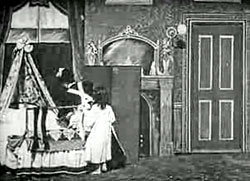 The very early silent fantasy film Santa Claus; aka, A Visit from Santa Claus (1898) is only a minute & a quarter long, but embodies one of the earliest special effect sequences, & an editing technique between roof & house interior advanced for its day.
The very early silent fantasy film Santa Claus; aka, A Visit from Santa Claus (1898) is only a minute & a quarter long, but embodies one of the earliest special effect sequences, & an editing technique between roof & house interior advanced for its day.
A nurse or nanny puts the two little children to bed, tucks them in, & leaves the room.
Superimposed in a circle that appears in the darkness on the wall beside the bed, we see what the children are dreaming.
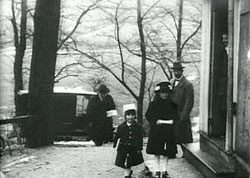 Santa is on the roof! He drops a Christmas tree down the chimney, then climbs in after, into the fireplace in the children's room. Santa is on the roof! He drops a Christmas tree down the chimney, then climbs in after, into the fireplace in the children's room.
Santa approaches the children's bed with a present, but vanishes when the children awake.
In another early silent Christmas film, the half-minute documentary TR Calls on Neighbors at Christmas (1917), we see Teddy Roosevelt at Oyster Bay, New York, bringing a gift to a neighbor's house.
The entire event occurs on the front stoop. In the background we can see the family car, & the lane up which Teddy saunters. Family members are coming & going through the door, but they never invite Roosevelt inside.
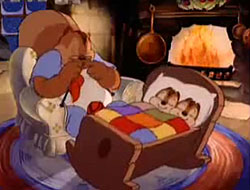 A Technicolor film by Hugh Harman, Peace on Earth (1939), opens with an image of a cathedral in ruins, eerie but still very beautiful in the snowfall. We hear a children's choir singing "Hark the Herald Angels Sing."
A Technicolor film by Hugh Harman, Peace on Earth (1939), opens with an image of a cathedral in ruins, eerie but still very beautiful in the snowfall. We hear a children's choir singing "Hark the Herald Angels Sing."
The camera pans right & we see a canon, then barbed wire, & realize this is a scene of carnage & war. This is pretty harsh stuff for a sweet cartoon for the kiddies, but it's 1939 after all. And it's going to get a lot grimmer before peace on Earth is possible.
The choir turns out to be three young squirrels, who are caroling in the squirrel village. The older houses are miniatures of a full-sized hamlet, but newer houses are made of soldiers' helmets.
In one home, a mother chipmunk is rocking her two chipmunk babies in their cradle. But they're roused from their bed when their old grampa arrives full of Christmas spirit. This is a mixed race family since the chipmonks' grampa's a grey squirrel.
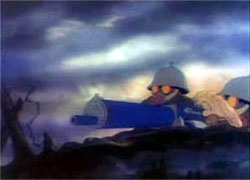 When grampa says "Peace on Earth, goodwill toward men," the grandkids ask, "What are men, grampa?" "Yeah, what are men?" When grampa says "Peace on Earth, goodwill toward men," the grandkids ask, "What are men, grampa?" "Yeah, what are men?"
Seated in a big easy chair with the little chippers in his lap, he begins to tell the story, which begins, "Well, there ain't no men in the world no more, sonnies. But as I remember the critters, they was like monsters. They wore great big iron pots on their heads, & walked on their hind legs. They carried terrible lookin' shootin' irons, with knives on the end of them. And they had great big long snoots like this, curled down & fastened onto their stomachs."
We see a frightening dark image of a man in helmet & gas mask stalking through the night. Some of this frightening imagery uses the rotoscope technique pioneered by Max Fleischer. Several of the animators had fought in World War I, & were close to the material.
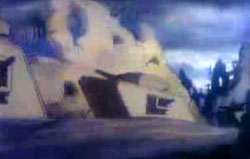 The two chippers are shivering with fright! "Oh, grampa, I'm glad there ain't no more men around!" Grampa's story of the world war continues, with the grimmest nightmare images to convey the nature of mankind -- gothic tanks, marching men in black boots, bombs busting everywhere, planes crashing, canons firing, shattered landscapes. As they ran out of anything else to fight about, it came down to the flat-footed people at war with the bucktooth people, & vegetarians at war with the meat eating people. "They fought & they fought & they fought -- until there was only two of them left." The two chippers are shivering with fright! "Oh, grampa, I'm glad there ain't no more men around!" Grampa's story of the world war continues, with the grimmest nightmare images to convey the nature of mankind -- gothic tanks, marching men in black boots, bombs busting everywhere, planes crashing, canons firing, shattered landscapes. As they ran out of anything else to fight about, it came down to the flat-footed people at war with the bucktooth people, & vegetarians at war with the meat eating people. "They fought & they fought & they fought -- until there was only two of them left."
Crawling out of their foxholes, the last two men of Earth gun one another down. And that, dear children, is how there came to be peace on Earth. The animals of the world "rebuild the old waste" & thereafter there is peace on Earth.
Damn but this is a good cartoon. It was rumored to have been considered for a Nobel Prize, which if true certainly would've been justified. It was nominated for an Oscar but lost out to a Donald Duck cartoon. In 1994 it was given the #40 slot on a list of the fifty greatest cartoons of all time, voted by a thousand animation professionals.
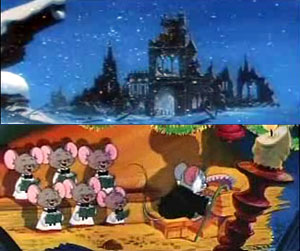 Peace on Earth really was one of the great cartoons of its era, & did not need a remake. But Hanna-Barbera remade it anyway, with mice instead of squirrels & chipmunks, in Cinemascope, as Good Will To Men (1955), replacing squirrels & chipmunks with mice.
Peace on Earth really was one of the great cartoons of its era, & did not need a remake. But Hanna-Barbera remade it anyway, with mice instead of squirrels & chipmunks, in Cinemascope, as Good Will To Men (1955), replacing squirrels & chipmunks with mice.
Their justification for remaking such a classic seems to have been the atomic bomb, which mad the end of humanity seem even more likely.
This added filip actually undermines the story a bit by making it so obviously an "atomic scare" movie such as the US government was funding to make as propoganda. The original version prophetically implied pretty much the same development, without having to include a lecture on mutually assured destruction.
Although the revision is closer to the status quo than the studio may have realized, it nevertheless remains largely an anti-war short, & the backgrounds, if not the cell animation in front of it, are beautifully designed.
It opens on a similarly gorgeous Cathedral in ruins. Inside the ruins, six mouse children are singing "Peace on Earth" while the elderly mouse choralmaster plays a tiny organ.
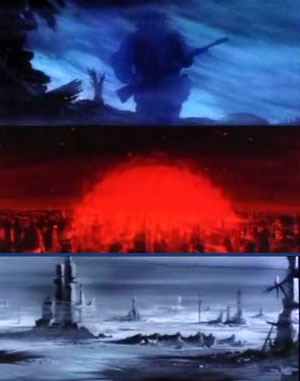 When they're finished, the old mouse tells the children, "Peace on Earth was a good idea. Too bad they didn't practice what they preached." When they're finished, the old mouse tells the children, "Peace on Earth was a good idea. Too bad they didn't practice what they preached."
"Who didn't practice what they preached?" one of the little mice asks, & is told, "Why, men!" "What are men?" "Yeah, what are they?"
"I guess that was before your time, boys. Well, there ain't no more men in the world. Nope. No more men. But as I remember, well, they was awful looking things...."
Terrible images of war & of monstrous soldiers with flame throwers, bazookas, machineguns, fighting on the ground, fighting in the air, always fighting, all gruesomely depicted. Before the end, there was nothing left but miles upon miles of graveyards.
They built bombs big enough to destroy entire cities, the old mouse-minister's story continues, to gruesome images to scare the bejabbers out of the whole family. Nuclear war erupted & the two major powers each eradicated half the world. "And that was the end of the last man on Earth."
But the animals recovered. "Everything was quite & kind of peaceful like." They gathered in the church, & the wise old owl taking lessons from "a book of rules that belonged to men," including Love thy neighbor as thyself, & Thou shalt not kill. Forever after, the Bible was the book of the world of beasts, & peace on Earth was finally a reality.
Not as moody & horrifying as the original, but still a pretty hard hitting lesson. Like the original, it garnered an Oscar nomination, but lost out to a Speedy Gonzales cartoon -- which is all the more a cretinish choice given that the year's authentically best cartoon, One Froggy Evening (1955), wasn't even considered.
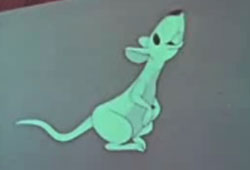 Produced in England with Lutheran funding, The Candlemaker (1957) opens on a snowy day outside a rural village church.
Produced in England with Lutheran funding, The Candlemaker (1957) opens on a snowy day outside a rural village church.
A narrator tells us this takes place before the time of automobiles & electricity; before the time of gaslamps even. The style unfortunately is minimalist for animation & not particularly aesthetic as to design.
In the village is a candlestick maker with a young son, Tom. Inside the candle shop, father & son are busy melting wax & dipping wicks for the manufacture of candles. The candlemaker donates his best candles to the church, as an offering to God.
Tom keeps a white mouse in his pocket, which likes to come out now & then & kiss him. The mouse also loves a little treat of candlewax.
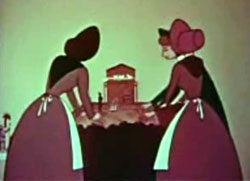 The next Sunday in church, the mouse climbs out of Tom's pocket & runs up his father's pant-leg. The candlemaker catches the mouse & puts it in his own pocket, then gives a mild scowl at his son for nearly causing a rukus in God's house. The next Sunday in church, the mouse climbs out of Tom's pocket & runs up his father's pant-leg. The candlemaker catches the mouse & puts it in his own pocket, then gives a mild scowl at his son for nearly causing a rukus in God's house.
The Lutherans weren't going to put up money to see a lot about early Victorian candlemaking, so we have to sit through a horrible, horrible service, dull enough to induce any young viewer to pray every Saturday night, "Please God, bless mommy & daddy, & don't make me have to get up & go to church tomorrow."
We have to listen to hymns ("Good Christian Men Rejoice" & "Beautiful Savior") & even a damned sermon, in which the preacher praises the candlemaker for giving the best of his candles to the church, & excoriating the rest of the congregation to give the church their best stuff too. Ahh, Lutheranism.
There's a second offering to be made specifically for Christmas Eve, but father has candles to deliver by horse & buggy throughout the county.
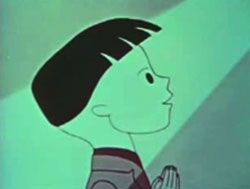 So young Tom is for the first time entrusted with the important duty of making the next offering of altar candles. Tom, however, gets so side-tracked playing with & teaching tricks to his mouse, that evening approaches & the altar candles are unmade. So young Tom is for the first time entrusted with the important duty of making the next offering of altar candles. Tom, however, gets so side-tracked playing with & teaching tricks to his mouse, that evening approaches & the altar candles are unmade.
The pastor in his church is getting worried, but Tom does make it at the last minute. Because of his haste, however, one of the candles is quite a bad one, & burns out with a smoky stench.
They make it through the whole hymn "Joy to the World," then go home & get depressed because after all these years, a worthless candle was delivered to the Lord.
Tom whinges to Squeeky about having let his parents & God down. He goes into the workshop & stays up through the night making a perfect candle to replace the one he got wrong, so that everything will be fine come Christmas morning. Overall, except for the mouse, a pretty stinky cartoon.
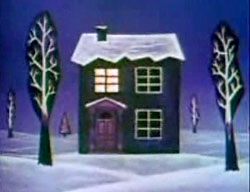 In the limited-animation style of John Halas & Joy Batchelor, The Christmas Visitor (1959) begins with a straightforward narrator's reading of "The Night Before Christmas" while showing stationary scenes of not a creature stirring.
In the limited-animation style of John Halas & Joy Batchelor, The Christmas Visitor (1959) begins with a straightforward narrator's reading of "The Night Before Christmas" while showing stationary scenes of not a creature stirring.
Halas & Batchelor were not noted for wit or irony, but they do much better than usual with this take-off on the famed poem, & is almost perverse in a couple spots.
As the classic poem asserts, the father of the household hears a clatter & wakes up to be witness to Santa's arrival by air, drawn by eight tiny reindeer.
There is originality to the design for Santa. Save only for white mustache & beard, he is bright read from head to toe, & manic like some kind of fiery devil. He's not particularly fat, & stands in his sled very animatingly whipping his reindeer.
He's actually kind of frightening, but cute enough to overcome the possiblity of tiny susceptible kids crapping their pants over him. He's a mind-reading Santa & after reaching the house through the chimney, he can tell what each sleeper wants for Christmas just by looking at him or her.
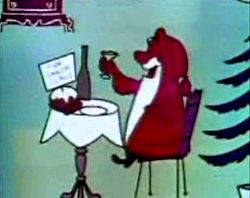 Santa's doings inside the house are amusing. And very unexpectedly, instead of milk & cookies left for him, he's thrilled to find a wine bottle & wine glass. Santa's doings inside the house are amusing. And very unexpectedly, instead of milk & cookies left for him, he's thrilled to find a wine bottle & wine glass.
By now the narrator has left off reciting the poem, as the specific descriptions of Santa would not have fit this character design.
Wandering entirely from the poem's content, we get episodes of toys coming to life. While the devilish though kindly Santa boozes it up, the toys unwrap themselves & come alive. A music box girl twirls around.
When she sees a sailor in a wheeled boat role by, she gets sexually aggressive from her desire for the little fellow, who is instantly smitten. The sailor has no lower part & cannot leave his wheeled boat, so all his heroics to come must be done while sailing about the room.
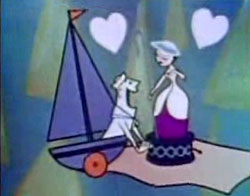 A Snidely Whiplash sort of Jack in the Box "springs" itself out of the box & bounces around the room. He becomes a threat to the music box girl. As in Perils of Pauline he ties her to the toy railroad track. A Snidely Whiplash sort of Jack in the Box "springs" itself out of the box & bounces around the room. He becomes a threat to the music box girl. As in Perils of Pauline he ties her to the toy railroad track.
While the sailor is busy saving the girl, Santa finishes up his wine, burps, lights a cigar, & only then do the toys all rewrap themselves, only now the music box girl is part of the sail boat, sailor of girl doll united in love.
We now return to the end of the poem, including Santa's "Happy Christmas to all & to all a good night!" parting.
Living toys had by 1959 been standard in Christmas cartoons for thirty years, & this one does not compare to the really great ones that came before. But the style is uniquely of the 1950s, the cigar-smoking wine-guzzling Santa is intriguingly creepy, & this cartoon rather makes up for the insipidity of the same English animation studio's The Candlemaker.
copyright © by Paghat the Ratgirl
|
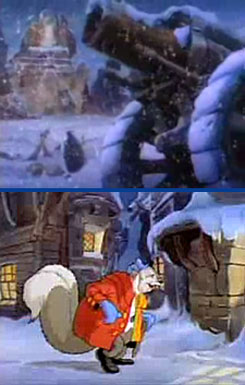

 Santa is on the roof! He drops a Christmas tree down the chimney, then climbs in after, into the fireplace in the children's room.
Santa is on the roof! He drops a Christmas tree down the chimney, then climbs in after, into the fireplace in the children's room.
 When grampa says "Peace on Earth, goodwill toward men," the grandkids ask, "What are men, grampa?" "Yeah, what are men?"
When grampa says "Peace on Earth, goodwill toward men," the grandkids ask, "What are men, grampa?" "Yeah, what are men?" The two chippers are shivering with fright! "Oh, grampa, I'm glad there ain't no more men around!" Grampa's story of the world war continues, with the grimmest nightmare images to convey the nature of mankind -- gothic tanks, marching men in black boots, bombs busting everywhere, planes crashing, canons firing, shattered landscapes. As they ran out of anything else to fight about, it came down to the flat-footed people at war with the bucktooth people, & vegetarians at war with the meat eating people. "They fought & they fought & they fought -- until there was only two of them left."
The two chippers are shivering with fright! "Oh, grampa, I'm glad there ain't no more men around!" Grampa's story of the world war continues, with the grimmest nightmare images to convey the nature of mankind -- gothic tanks, marching men in black boots, bombs busting everywhere, planes crashing, canons firing, shattered landscapes. As they ran out of anything else to fight about, it came down to the flat-footed people at war with the bucktooth people, & vegetarians at war with the meat eating people. "They fought & they fought & they fought -- until there was only two of them left."
 When they're finished, the old mouse tells the children, "Peace on Earth was a good idea. Too bad they didn't practice what they preached."
When they're finished, the old mouse tells the children, "Peace on Earth was a good idea. Too bad they didn't practice what they preached."
 The next Sunday in church, the mouse climbs out of Tom's pocket & runs up his father's pant-leg. The candlemaker catches the mouse & puts it in his own pocket, then gives a mild scowl at his son for nearly causing a rukus in God's house.
The next Sunday in church, the mouse climbs out of Tom's pocket & runs up his father's pant-leg. The candlemaker catches the mouse & puts it in his own pocket, then gives a mild scowl at his son for nearly causing a rukus in God's house. So young Tom is for the first time entrusted with the important duty of making the next offering of altar candles. Tom, however, gets so side-tracked playing with & teaching tricks to his mouse, that evening approaches & the altar candles are unmade.
So young Tom is for the first time entrusted with the important duty of making the next offering of altar candles. Tom, however, gets so side-tracked playing with & teaching tricks to his mouse, that evening approaches & the altar candles are unmade.
 Santa's doings inside the house are amusing. And very unexpectedly, instead of milk & cookies left for him, he's thrilled to find a wine bottle & wine glass.
Santa's doings inside the house are amusing. And very unexpectedly, instead of milk & cookies left for him, he's thrilled to find a wine bottle & wine glass. A Snidely Whiplash sort of Jack in the Box "springs" itself out of the box & bounces around the room. He becomes a threat to the music box girl. As in Perils of Pauline he ties her to the toy railroad track.
A Snidely Whiplash sort of Jack in the Box "springs" itself out of the box & bounces around the room. He becomes a threat to the music box girl. As in Perils of Pauline he ties her to the toy railroad track.